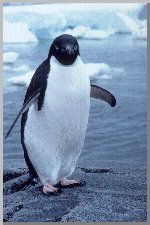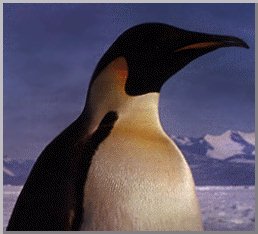
|
|





|







 Name: King Penguin (Aptenodytes patagonicus)
Name: King Penguin (Aptenodytes patagonicus)Home: Islands in sub-Antarctic Oceans
Status in Wild: Not threatened or endangered
Foods: Fish, squid and krill
Penguins are stout-bodied, short-legged, flightless birds superbly adapted for swimming underwater. Their wings resemble flippers and their bodies are covered with short, scaly feathers with downy bases.
All 6 genera and 18 species are blackish above and white below, but some are banded across the breast and others have ornamental yellow crests.
Penguins are found in the colder waters of Oceans of the Southern
Hemisphere, breeding near the Equator on the Galapagos Archipelago,
in southern South America and Africa, in Australia and New Zealand,
and on many islands.
Only two species, the Aadelie and the Emperor, breed in Antarctica.
Although penguins feed mainly on small crustaceans (krill), fish, and squid near the surface, tha emperor penguin may descend up to 260m (850 ft) in search of food.
Penguins gather into large colonies to breed, returning year after year to the same rookery. The colonies are noisy with harsh calls and alive with the antics of courtship or mutual displays in which the wings are typically held extended and the bill pointed skyward.
These penguins build no nest. Instead, both parents take turns
incubating their one egg on the top of their feet. They keep
the egg warm with a special skin fold.
 The female emperor penguin lays her egg in May and then goes to
sea to feed while the male incubates continuosly for two months
without eating. When the female returns to care for the newly hatched
chick, the male goes to sea to regain his lost weight. Chicks feed
by reaching into their parents' throats for food that is brought
from the sea. Mortality of the chicks is often high (40 to 80%)
because of severe storms and predation by skuas and sheatbills.
Although their eggs were once harvested and adults slaughtered for
their oil and skin, penguins are now widely protected.
The female emperor penguin lays her egg in May and then goes to
sea to feed while the male incubates continuosly for two months
without eating. When the female returns to care for the newly hatched
chick, the male goes to sea to regain his lost weight. Chicks feed
by reaching into their parents' throats for food that is brought
from the sea. Mortality of the chicks is often high (40 to 80%)
because of severe storms and predation by skuas and sheatbills.
Although their eggs were once harvested and adults slaughtered for
their oil and skin, penguins are now widely protected.
Penguins are often mistakenly associated with the tundra because this
biome is characterized by harsh conditions, cold and snow. And penguins
are birds that live in such environmental conditions, spending much of
their time at sea, but, strictly speaking, penguins occur at the
opposite end of the earth from the tundra at southern latitudes and
the Antarctic.
These penguins live in more temperate waters than those closer to the
South Pole, so they have less protective fat than other cold-weather
penguins. Their feathers are waterproof - perfect for swimming.
Besides the standard black-and-white penguin tuxedo, this bird sports
yellow feathers on its neck and chest.
Go to the top of the page